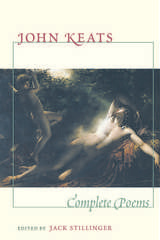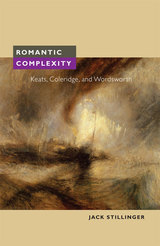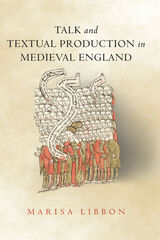
Here is the first reliable edition of John Keats’s complete poems designed expressly for general readers and students.
Upon its publication in 1978, Jack Stillinger’s The Poems of John Keats won exceptionally high praise: “The definitive Keats,” proclaimed The New Republic—“An authoritative edition embodying the readings the poet himself most probably intended, prepared by the leading scholar in Keats textual studies.”
Now this scholarship is at last available in a graceful, clear format designed to introduce students and general readers to the “real” Keats. In place of the textual apparatus that was essential to scholars, Stillinger here provides helpful explanatory notes. These notes give dates of composition, identify quotations and allusions, gloss names and words not included in the ordinary desk dictionary, and refer the reader to the best critical interpretations of the poems. The new introduction provides central facts about Keats’s life and career, describes the themes of his best work, and speculates on the causes of his greatness.

After more than a century of study, we know more about John Keats than we do about most writers of the past, but we still cannot fully grasp the magical processes by which he created some of the most celebrated poems in all of English literature. This volume, containing 140 photographs of Keats’s own manuscripts, offers the most concrete evidence we have of the way in which his thoughts and feelings were transmuted into art.
The rough first drafts in particular are full of information about what occurred, if not in Keats’s mind, at least on paper when he had pen in hand: the headlong rush of ideas coming so fast that he had no time to punctuate or even form the letters of his words; the stumbling places where he had to begin again several times before the words resumed their flow; the efforts to integrate story, character, and theme with the formal requirements of rhyme and meter. Each revision teaches the inquiring reader something about Keats’s poetic practice.
Several of the manuscripts are unique authoritative sources, while others constitute our best texts among multiple existing versions. They reveal much about the maturation of the poet’s creativity during four years of his brief life, between “On Receiving a Curious Shell” (1815) and “To Autumn” (1819). Above all, they show us what is lost when penmanship yields to the printed page: what Helen Vendler, in her insightful essay on the manuscripts, calls “the living hand of Keats.” These sharply reproduced facsimiles provide compelling visual evidence of a mortal author in the act of composing immortal works.


Here at last is the definitive Keats—an edition of John Keats’s poems that embodies the readings the poet himself most probably intended. The culmination of a tradition of literary and textual scholarship, it is the work of the one scholar best qualified to do the job.
Largely because of the wealth and complexity of the manuscript materials and the frequency with which first printings were based on inferior sources, there has never been a thoroughly reliable edition of Keats. Indeed, in The Texts of Keats’s Poems Jack Stillinger demonstrated that fully one third of the poems as printed in current standard editions contain substantive errors. This edition is the first in the history of Keats scholarship to be based on a systematic investigation of the transmission of the texts. The readings given here represent in each case, as exactly as can be determined, the version that Keats preferred. The chronological arrangement of the poems and the full record of variants and manuscript alterations (presented in a style that will be clear to the general reader as well as useful to the scholar) display the development of Keats’s poetic artistry. Notes at the back provide dates of composition, relate extant manuscripts and early printings, and explain the choices of texts.
The London Times said of Stillinger’s earlier study of the texts: “Thanks to Mr. Stillinger a revolution in Keats studies is at hand.” Here is the crucial step in that revolution.

In Romantic Complexity, Jack Stillinger examines three of the most admired poets of English Romanticism--Keats, Coleridge, and Wordsworth--with a focus on the complexity that results from the multiple authorship, the multiple textual representation, and the multiple reading and interpretation of their best works.
Specific topics include the joint authorship of Wordsworth and Coleridge in the Lyrical Ballads, an experiment of 1798 that established the most essential characteristics of modern poetry; Coleridge's creation of eighteen or more different versions of The Ancient Mariner and how this textual multiplicity affects interpretation; the historical collaboration between Keats and his readers to produce fifty-nine separate but entirely legitimate readings of The Eve of St. Agnes; and a number of practical and theoretical matters bearing on the relationships among these writers and their influences on one another.
Stillinger shows his deep understanding of the poets' lives, works, and the history of their reception, in chapters rich with intriguing questions and answers sure to engage students and teachers of the world's greatest poetry.

Jack Stillinger's concern is with the words of Keats's texts: “I wish,” he says, “to get rid of the wrong ones and to suggest how to go about constructing texts with a greater proportion of the right ones.” He finds that in the two best modern editions of Keats, one third of the texts have one or more wrong words. Modern editors have sometimes based their texts on inferior holograph, transcript, or printed versions; sometimes combined readings from separate versions; sometimes retained words added by copyists and early editors (who frequently made “improvements” when they thought the poems needed them); and sometimes, of course, introduced independent errors of their own.
The heart of this book is a systematic account of the textual history of each of the 150 poems that can reasonably be assigned to Keats. In each history Stillinger dates the work, as closely as it can be dated; gives the details of first publication; specifies the existing variant readings and their sources; and suggests what might be the basis for a standard text.
READERS
Browse our collection.
PUBLISHERS
See BiblioVault's publisher services.
STUDENT SERVICES
Files for college accessibility offices.
UChicago Accessibility Resources
home | accessibility | search | about | contact us
BiblioVault ® 2001 - 2025
The University of Chicago Press









